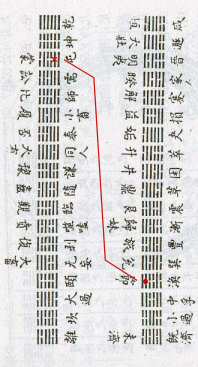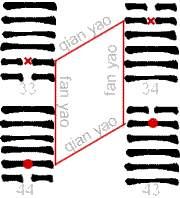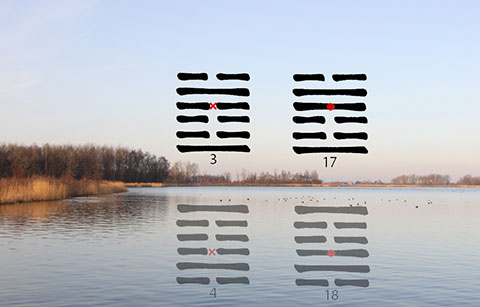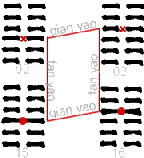I Ching, Yijing or Zhou Yi
"Oracle of the moon": © 2000 LiSe
 Yi Jing, Oracle of the Moon
Yi Jing, Oracle of the Moon

Guà Jìng - Yáo Ying
Hexagram Mirrors and Line Reflections
(the line pathways)
Many hexagram lines have a mirror now, you find it below the lines in each hexagram.

This diagram (without the red line) comes from a paper by Edward Hacker and Steve Moore – 'A brief note on the two-part division of the received order of the hexagrams in the Zhouyi' published in the June 2003 issue of the Journal of Chinese Philosophy (30:2, pp 219–221). They discovered a diagram showing their idea was known in the Yuan (Mongol) dynasty. See Steve Marshall, last atricle on the page
It seems to solve the mystery of the division of the hexagrams in two unequal parts (the 'upper' canon of 30 and 'lower' of 34 hexagrams).
The hexagrams have the hexagram name written at one side, and the name of its inverted one upside down on the other side (I rotated the diagram 90°). So a hexagram, which does not change when inverted, should have on both sides the same name. In the diagram these double names are left blank (eg lower left corner).
It occurred to me that every pair of inverted hexagrams makes three cohesive groups with three other pairs through a set of four lines. Always lines 1-6, 2-5 or 3-4. There are 96 groups, 64 x 3/2. They are mirrored or reflected, side by side or upside-down.
For the 'mirrors' or line pathways it explains the relation of e.g. hex.3 line 2 with hex.4 line 5 (third hex. at left) and with hex.59 line 5 and 60 line 2. Hex.3 line 2 is fan-yao of hex.60 line 2 (when 3.2 changes, 60.2 corresponds with 3.2), and qian-yao with hex.4 line 5 (hex.3 upside down is hex.4, line 3.2 becomes 4.5).
To find the Mirror grouping for a specific line: go to its hexagram, and click on the Mirror of this line.
An example, Mirror grouping 33.2-44.2-43.5-34.5

Mirror 33.2-43.5
What about hexagrams which do not change when upside down, like hex.2:
The paired hexagram of hex.2 is hex.2, because upside down is it still hex.2. What changes is the line: now it is line 4.

Mirror 2.3-15.3 This is an image of the line pathway starting at hex.2 line 3. Hex.2 is at the top left, with line 3 changing. Top right its fanyao 15.3. Bottom right hex.2, line 4 changing, bottom left its fanyao 16.4. If you mirror or rotate the image makes no difference.

Another way to show the mirrors
Left-right the fan-yao,
top-bottom the reflections (the 'pairs').

Top right the qianyao of hex.2: its paired hexagram, which is again hex.2, but now with line 4 changing. Bottom right the fanyao of 2.4, which is 16.4.
Every Mirror grouping has a theme, depending on the lines and hexagrams involved. In the first example above, 33.2, the theme was how to deal with "possessing".
The theme of the mirror grouping of 2.3 is, that everything essential you do comes from your heart, not from what your brain wants. Wanting is limited and gives small results, following your heart or 'guts' is big. This kind of strong intention can cause ripples in space-time.
Heartfelt motivation attracts others (16.4)
you act from out your heart, not towards a result (2.3)
in cooperation, you give all of yourself (15.3)
when your heart is silent, you are silent (2.4)